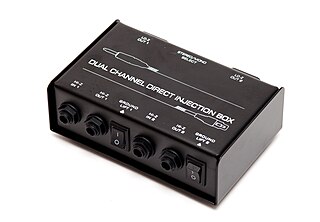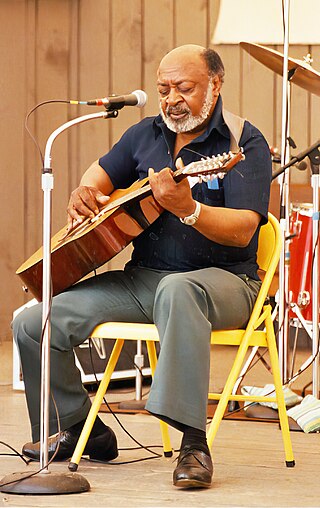
A microphone, colloquially called a mic, or mike, is a transducer that converts sound into an electrical signal. Microphones are used in many applications such as telephones, hearing aids, public address systems for concert halls and public events, motion picture production, live and recorded audio engineering, sound recording, two-way radios, megaphones, and radio and television broadcasting. They are also used in computers and other electronic devices, such as mobile phones, for recording sounds, speech recognition, VoIP, and other purposes, such as ultrasonic sensors or knock sensors.

A DI unit is an electronic device typically used in recording studios and in sound reinforcement systems to connect a high output impedance unbalanced output signal to a low-impedance, microphone level, balanced input, usually via an XLR connector and XLR cable. DIs are frequently used to connect an electric guitar or electric bass to a mixing console's microphone input jack. The DI performs level matching, balancing, and either active buffering or passive impedance matching/impedance bridging. DI units are typically metal boxes with input and output jacks and, for more expensive units, “ground lift” and attenuator switches.
Shure Incorporated is an audio products corporation headquartered in the USA. It was founded by Sidney N. Shure in Chicago, Illinois, in 1925 as a supplier of radio parts kits. The company became a consumer and professional audio-electronics manufacturer of microphones, wireless microphone systems, phonograph cartridges, discussion systems, mixers, and digital signal processing. The company also manufactures listening products, including headphones, high-end earphones, and personal monitor systems.

A boundary microphone is one or more small omnidirectional or cardioid condenser mic capsule(s) positioned near or flush with a boundary (surface) such as a floor, table, or wall. The capsule(s) are typically mounted in a flat plate or housing. The arrangement provides a directional half-space pickup pattern while delivering a relatively phase-coherent output signal.

The Shure SM58 is a professional cardioid dynamic microphone, commonly used in live vocal applications. Produced since 1966 by Shure Incorporated, it has built a reputation among musicians for its durability and sound, and is still the industry standard for live vocal performance microphones. The SM58 is the most popular live vocal microphone in the world. It is a development of the SM57 microphone, which is another industry standard for both live and recorded music. In both cases, SM stands for studio microphone.

The Neumann U 47 is a large-diaphragm condenser microphone. It is one of the most famous studio microphones and was Neumann's first microphone after the Second World War. The original series, manufactured by Georg Neumann GmbH between 1949 and 1965, employed a tube design; early U 47s used the M 7 capsule, then replaced by the K 47 from 1958. Units produced before 1950 were distributed by Telefunken and bear the Telefunken logo.

The RCA Type 77-DX microphone is a poly-directional ribbon microphone, or pressure-gradient microphone, introduced by the RCA Corporation in 1954. It was preceded by the Type 77-D introduced in 1948. Its popularity and classic design has resulted in the 77-DX becoming an iconic microphone, used by broadcasters and media personalities such as Edward R. Murrow, David Letterman and Larry King.

There are a number of well-developed microphone techniques used for recording musical, film, or voice sources or picking up sounds as part of sound reinforcement systems. The choice of technique depends on a number of factors, including:

AKG Acoustics is an acoustics engineering and manufacturing company. It was founded in 1947 by Rudolf Görike and Ernest Plass in Vienna, Austria. It is a part of Harman International Industries, a subsidiary of Samsung Electronics since 2017.

The H2 Handy Recorder is a handheld digital audio recorder from Zoom first announced at the NAMM Show in February 2007. It records very high quality digital stereo or 4-channel audio on a hand-held unit, and has been called "the studio on a stick."

The proximity effect in audio is an increase in bass or low frequency response when a sound source is close to a directional or cardioid microphone. Proximity effect is a change in the frequency response of a directional pattern microphone that results in an emphasis on lower frequencies. It is caused by the use of ports to create directional polar pickup patterns, so omni-directional microphones do not exhibit the effect
The Shure Beta 58A is a rugged dynamic supercardioid microphone developed by Shure Incorporated specifically for live vocal performances. The microphone won a TEC Award in 1996 for outstanding microphone technology.

A Y-cable, Y cable, or splitter cable is a cable with three ends: one common end and two other ends. The Y-cable can resemble the Latin letter "Y".
In live sound mixing, gain before feedback (GBF) is a practical measure of how much a microphone can be amplified in a sound reinforcement system before causing audio feedback. In audiology, GBF is a measure of hearing aid performance. In both fields the amount of gain is measured in decibels at or just below the point at which the sound from the speaker driver re-enters the microphone and the system begins to ring or feed back. Potential acoustic gain (PAG) is a calculated figure representing gain that a system can support without feeding back.

The Shure MV7 is a cardioid dynamic microphone used for podcasting and home studio applications. The MV7 was developed in 2020 by Shure as a digital audio reworking of the classic SM7B professional broadcasting microphone. The MV7 was rated the best podcasting microphone by Rolling Stone in their 2021 Audio Awards.

The Shure SM7 is a professional cardioid dynamic microphone, commonly used in broadcasting applications since 1973. Designed by Shure, it has been described as an "iconic" industry standard microphone for its focused, directional sound and its widespread adoption in radio, television and recording studios. In 2007–2008, the SM7B model became popular for professional podcasting.

The Sennheiser MD 421 is a German cardioid dynamic microphone, widely used for speech in broadcasting and for music in live concerts and the recording studio. Introduced in 1960, the internal large-diaphragm transducer element of the MD 421 is still produced unchanged by Sennheiser. The MD 421 is considered a classic, an industry standard. More than 500,000 units have been sold.

The Electro-Voice RE20 is an American professional cardioid dynamic microphone, commonly used in broadcasting applications since 1968. Designed by Electro-Voice using the company's patented Variable-D technology and a large-diaphragm element, it has been described as an industry standard "iconic" microphone for its natural sound and its wide usage in radio, television and recording studios. In 2015, the RE20 was inducted into the TEC Awards Technology Hall of Fame.

The Shure 55SH is a professional cardioid dynamic microphone that has been commonly used in broadcast applications since 1939. Designed by American audio products company Shure, it has been described as "iconic" in pamphlets and reviews, after the Elvis stamp issued by the U.S. Postal Service in 1993. It was widely adopted in radio, television, and recording studios. From the 1940s until the end of the 20th century, it maintained its popularity in the professional environment. Shure designed the Unidyne transducer in 1939 and then greatly improved it in 1959, based on research and development by Shure engineer Ernie Seeler.

The Neumann U 87 is a poly-directional large-diaphragm condenser microphone. Originally introduced in 1967, a version of the U 87 is still produced by Georg Neumann GmbH. The U 87 became an industry standard recording microphone, a reputation that continues to endure.


















